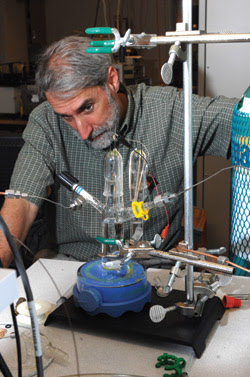A plan sketched out on the back of a paper placemat may one day result in portable, personal power.
It all began when Arunas A. Chesonis invited MIT professor Daniel G. Nocera to lunch and asked him what he would do with $10 million from the Chesonis Family Foundation – which funds renewable energy projects – to address the world’s energy needs. The response Nocera outlined resulted in The Solar Revolution Project, which was launched in April 2008 and now includes at least 30 researchers working on myriad solar and energy storage projects.

Daniel G. Nocera’s group at MIT uses the sun’s energy to split hydrogen and oxygen from any kind of water, using a cheap metal alloy as a catalyst. Photo by Donna Coveney, MIT.
One project involves a process similar to photosynthesis in that it stores solar energy in the form of fuel cells. It has been about a year since Nocera announced a major breakthrough in the work: the discovery of a catalyst that can convert water to oxygen gas. (A catalyst for hydrogen gas existed previously.)
Now that work has taken another giant step. The process uses the sun’s energy to split water into hydrogen and oxygen gases, which can be recombined inside a fuel cell to create energy. In photosynthesis, light is captured and converted into a spatially separated single electron-hole pair. Nature’s method and Nocera’s both split water into oxygen the same way; the major difference is in how hydrogen is made. Last year, when Nocera’s first breakthrough was reported, the researchers were using platinum, a fairly expensive element. Since then, they have replaced the platinum with a cheap cobalt alloy.
Plain water
They also have discovered that they can use just plain water – or even wastewater – with their cobalt catalyst and that, furthermore, the catalyst is self-healing. What that means is that, as in the process of photosynthesis, some of the catalyst naturally falls apart and is reconstructed from solar energy.
Nocera believes that this method has great potential for providing energy in places far off the grid, such as in poor villages in Africa. It would work by feeding surplus energy from a photovoltaic (PV) module into a system with the water-splitting catalyst to generate hydrogen and oxygen. When the sun wasn’t out and the PV module wasn’t generating energy, the stored hydrogen and oxygen could be recombined in a fuel cell to provide the electricity needed to power a home, cook food, run water-purifying systems and more.
In fact, Nocera said, the tiny energy station could draw water from the sea or a natural river stream and output fresh drinking water. Or it could draw from disease-ridden wastewater “and give pure water back.”
Potential applications also exist in developed areas of the globe, he noted, such as for various medical uses – “anywhere you’d want hydrogen and oxygen in a very concentrated way.”
The bottom line is that this personal solar energy storage method will provide a few hundred watts of useful, clean energy very inexpensively, he said.